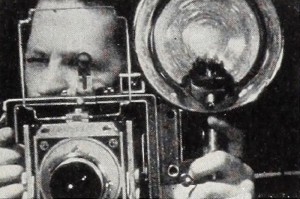
"Ralph W. Luce has made a record film of a day's outing by a group of cameramen, in which he proves that imaginative planning and concise cutting can make an interesting movie of what might otherwise be dull material. The continuity scheme used in Field Trip shows a waterfront scene being shot, its process through the darkroom and its final exhibition to win top prize among the group's endeavors. Flanking this theme are creative compositions that various cameramen might have recorded, as well as inserts of the workers choosing their viewpoints and setting their lenses. The lead and end titles are particularly stimulating. Mr. Luce has achieved pace in a film that might have been plodding. The result is marred only by the graininess of its monochrome emulsion." Movie Makers, Dec. 1950, 467.
"doc. a fantasia"/avant-garde documentary
"Vincente Mills, of Manila, Philippines, for his entry in the American Cinematographer 1933 competition will make a religious picture built around the practice in his country which takes place during Holy Thursday and Good Friday each year. As this practice is fast disappearing, according to Mills, it will also act as a fine historic record." American Cinematographer, Sept. 1933, 191.
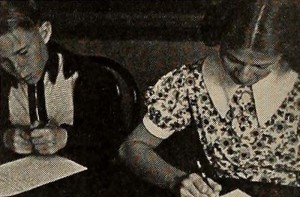
"First Film and When the Cat's Away, a double header entry, which takes honors jointly because of the strong relationship between the two, is the production of the Cinema Club of Lowell Junior High School, at Long Beach. Calif., and of the club's faculty adviser, Helen Rees Clifford. First Film, largely the work of Miss Clifford, summarizes the Junior High School group's experiences in producing When the Cat's Away, which is entirely the achievement of the youngsters. Together, the two films present a clear and concise picture of the initial production of a film by a junior high school movie club, from scenario writing and movie planning to the completed opus, ready for its premiere. So, in these two reels, one sees how the job of teaching movie making technique to youngsters, of ages from eleven to fourteen, can be handled efficiently and happily, and one learns how clear and coherent a little picture can be produced as a starter. Few high school photoplay clubs have begun so well and with so little lost motion. Very few high school first films are as clear and competent as When the Cat's Away." Movie Makers, Dec. 1938, 618.
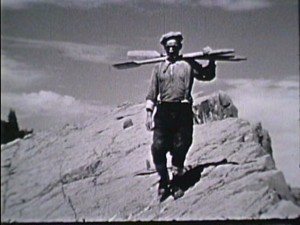
"In Fishers of Grande Anse, Leslie P. Thatcher, ACL, has compiled a vivid and crystal clear cinematic document of cod fishing in a little village in northern New Brunswick. This picture is a restrained work of art that depicts the austere beauty of toil. Repairing boats and nets, catching and cleaning the cod, salting and storing the fish for market and the fishermen leaving for home are the raw material from which this black and white production draws its rugged and satisfying beauty. Close shots and closeups (never affected or forced) comprise the simple devices whereby the irrelevant and possibly distracting material is excluded and whereby the magnificent compositions are achieved. The technical quality of the picture is superb, but probably Mr. Thatcher's greatest accomplishment is in his choice of camera viewpoint." Movie Makers, Dec. 1935, 550.
"Florida, a documentary film of that state, made in Kodacolor by H. W. Voss, ACL, has been given Honorable Mention because of the freshness and charm of its component subject matter. Replete with human interest material, such as sequences of wild turkeys, new born calves and clumsy, appealing puppies, the picture is a bright and amazing mine of simple entertainment. Though Mr. Voss slips occasionally from a uniformly high technical standard of color work, he need bow to no one in the warmth and charm which he finds and records everywhere in the life about him." Movie Maker, Dec. 1934, 546.
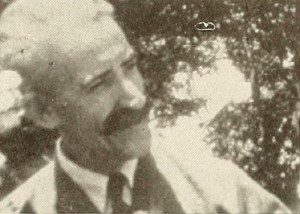
"Flowering Byways, presented with well chosen musical accompaniment, is a story of the creation and growth of a home garden, cleverly interwoven with the thread of human interest. In it, Ernest Kremer has made a thoroughly enjoyable and interesting record of his father in law's gardening ability. "Pop's garden" has its beginnings in the chilly days of early spring, when the bare ground gives little promise of the profusion of bloom that is to spring up under Pop's skillful hands. We follow with keen interest the growth of the garden through subsequent months. Mr. Kremer's skill in presentation being demonstrated by the constant variety of material and by the interpolation of well chosen touches of human interest. Finally, the apotheosis of Pop's garden creation is realized when he takes first prize at the local garden club show. The flower closeups here are always excellent, but they are not made an end in themselves." Movie Makers, Dec. 1941, 565.

"A community service in filming the activities of the George E. Slye School in East Hartford, Conn. We start with the young boys and girls on the playground, their orderly return to the classrooms. Then we visit the first and second grades to observe the teaching and learning methods. There is a lunch room, a dispensary, and an audio hearing test center. All learn to sing, blending their young voices in the classroom. Those who have the interest, are taught to use musical instruments and an appreciation of the drama. Physical education for good health is as important as Parent-Teachers organization meetings Focus on Slye is a truly fine community service" PSA Journal, Oct. 1962, 35.
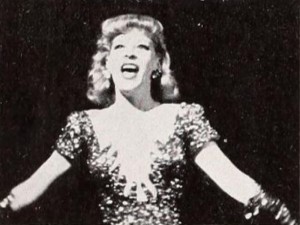
"Oscar H. Horovitz had, obviously, a certain amount of influence aiding his production of Follow the Girls, a motion picture study of the Gertrude Niesen musical comedy. This fact, however, does not explain the secret of his success. Others before him have had influence behind their filming of such dramatic spectacles as the circus, indoor ice carnivals, pageants and assorted stage shows. The influence did not help; their filming remained but a record, immobile and inanimate between the confines of a proscenium arch. Not so in Follow the Girls! Although executed with brilliant technical ability, the paramount triumph of this picture is its prevailing and sure sense of genuine cinematics. The cameraman seems to have been everywhere — on stage and off. Scenes of an ensemble or of a single singer cut in complete confidence from long shot to medium to closeup, without missing so much as a shoe tap. Follow the Girls, besides being lively and colorful entertainment, should serve as a model for all future personal movies of its kind and as an important record of this era of entertainment." Movie Makers, Dec. 1944, 477, 494.
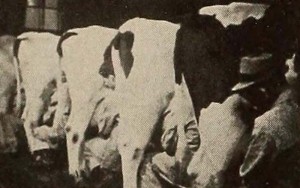
"Well known for its attainments in the commercial film field, the T. W. Willard Motion Picture Company sets a new high in its publicity productions with Follow the Plow. To technical excellence they have added sound sequencing; into a record of vocational education, they have instilled beauty and human interest. The subject matter concerns the training given to selected city boys in the fundamentals of farming at the Bowdoin Farm, operated by the Children's Aid Society of New York City. Tracing the course of these boys from the sidewalks and streets to the fields, at New Hamburg, N. Y., the location of the farm, the film expands with the glorious color of the autumn country and becomes a living essay of the pleasures of farm life. Constantly changing angles and intelligent titling lend pace to the production. Despite the limited interest in the specific subject of plows and cows, the appeal is made universal through magnificent color scenes and competent treatment." Movie Makers, Dec. 1938, 618.
Total Pages: 79